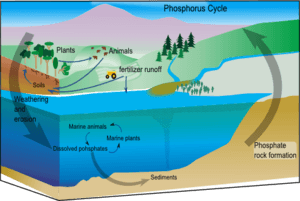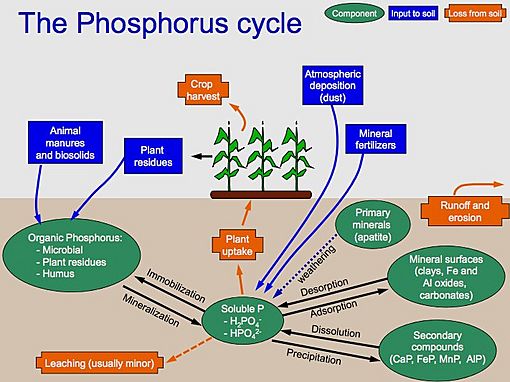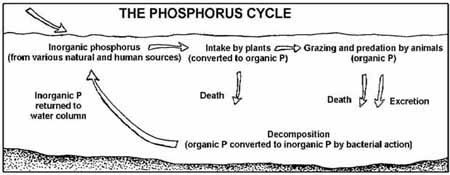Phosphorus cycle facts for kids
The phosphorus cycle is the biogeochemical cycle that describes the movement of phosphorus through the lithosphere, hydrosphere, and biosphere.
Phosphorus in the environment
Phosphorus is an essential nutrient for plants and animals. Phosphorus is a limiting nutrient for aquatic organisms. Phosphorus forms parts of important life-sustaining molecules that are very common in the biosphere. Phosphorus does enter the atmosphere in very small amounts when the dust is dissolved in rainwater and seaspray but remains mostly on land and in rock and soil minerals. Eighty percent of the mined phosphorus is used to make fertilizers. Phosphates from fertilizers, sewage and detergents can cause pollution in lakes and streams. Over-enrichment of phosphate in both fresh and inshore marine waters can lead to massive algae blooms. In fresh water, the death and decay of these blooms leads to eutrophication. An example of this is the Canadian Experimental Lakes Area.
These freshwater algal blooms should not be confused with those in saltwater environments. Recent research suggests that the predominant pollutant responsible for algal blooms in saltwater estuaries and coastal marine habitats is nitrogen.
Phosphorus occurs most abundantly in nature as part of the orthophosphate ion (PO4)3−, consisting of a P atom and 4 oxygen atoms. On land most phosphorus is found in rocks and minerals. Phosphorus-rich deposits have generally formed in the ocean or from guano, and over time, geologic processes bring ocean sediments to land. Weathering of rocks and minerals release phosphorus in a soluble form where it is taken up by plants, and it is transformed into organic compounds. The plants may then be consumed by herbivores and the phosphorus is either incorporated into their tissues or excreted. After death, the animal or plant decays, and phosphorus is returned to the soil where a large part of the phosphorus is transformed into insoluble compounds. Runoff may carry a small part of the phosphorus back to the ocean. Generally with time (thousands of years) soils become deficient in phosphorus leading to ecosystem retrogression.
Phosphorus cycling
The phosphorus cycle includes the following steps:
- Phosphorus in fertilizer, rocks, and mountains is distributed by rain to nearby land and bodies of water
- Animals eat the plants grown by fertilizer. They expel the phosphorus as waste. It eventually reaches the water as runoff.
- Phosphorus is cycled through animals that live in water. It is eventually deposited into the ocean floor.
- Phosphates contribute to the sediment at the bottom of the water. That sediment becomes rock.
- The ocean bed eventually becomes a mountain range over several millions of years because of normal geological functions.
- The phosphorus in those mountain ranges is washed off into bodies of water and the cycle begins again.
Images for kids
See also
 In Spanish: Ciclo del fósforo para niños
In Spanish: Ciclo del fósforo para niños







